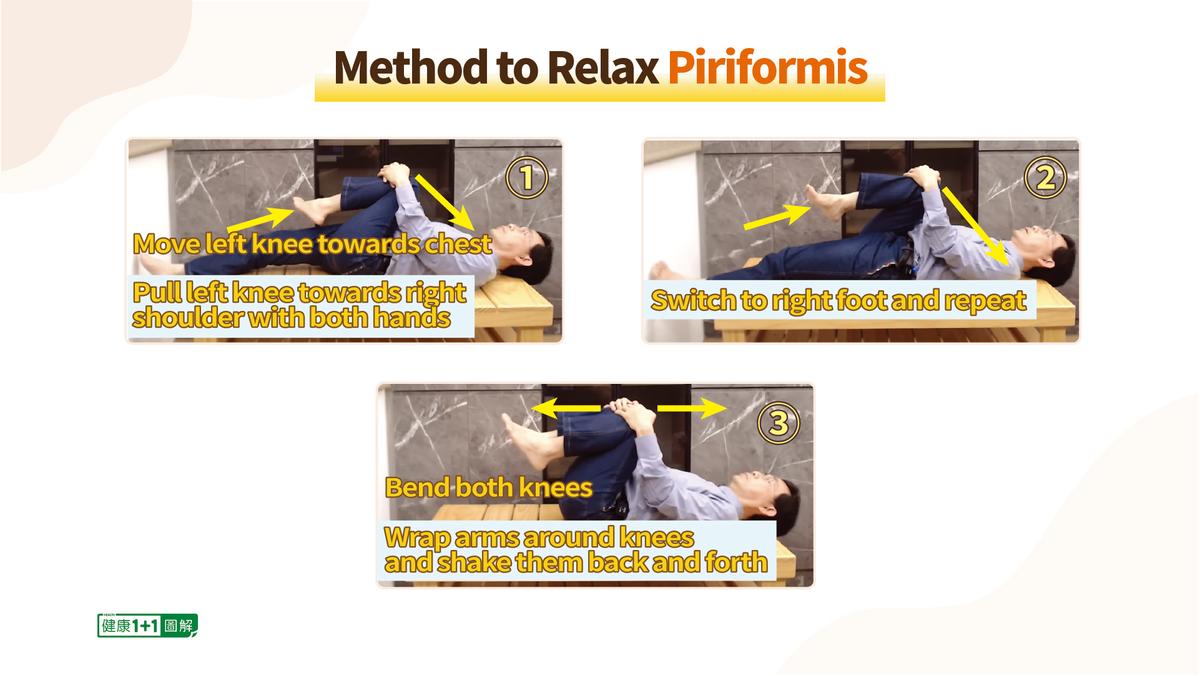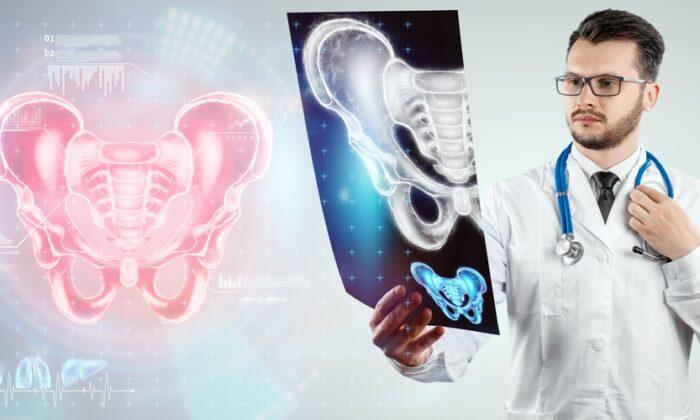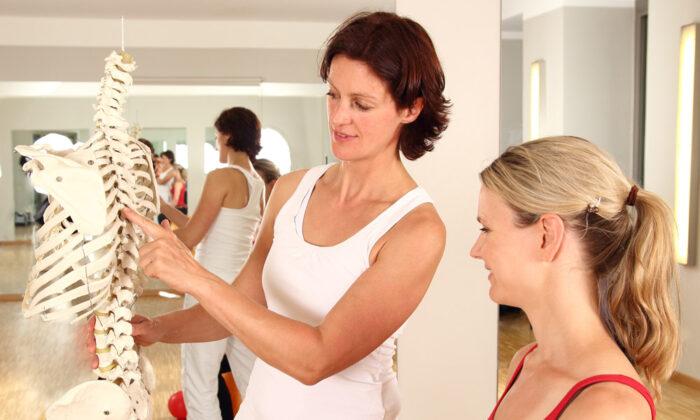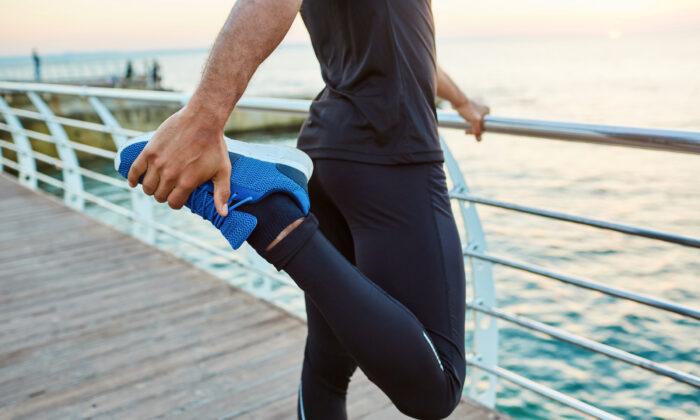Modern people’s sedentary lifestyle and poor posture, including leg crossing, can all cause pelvic distortion and misalignment. The pelvis is the foundation of the body’s balance, and once pelvic misalignment occurs, it not only leads to a bulging abdomen and large hips, but it also easily causes lumbar and back pain, hip and leg pain, and even knee pain.
What is Pelvic Misalignment?
The pelvis is mainly composed of the ilia, ischia, and sacrum; and pelvic misalignment refers to these bones leaning or being tilted to one side.The ilia can tilt in many directions, and they can have three major types of abnormal positions: anterior tilting, inward or outward turning, and upward or downward shifting; while the tailbone (i.e. coccyx) tends to bend inward.
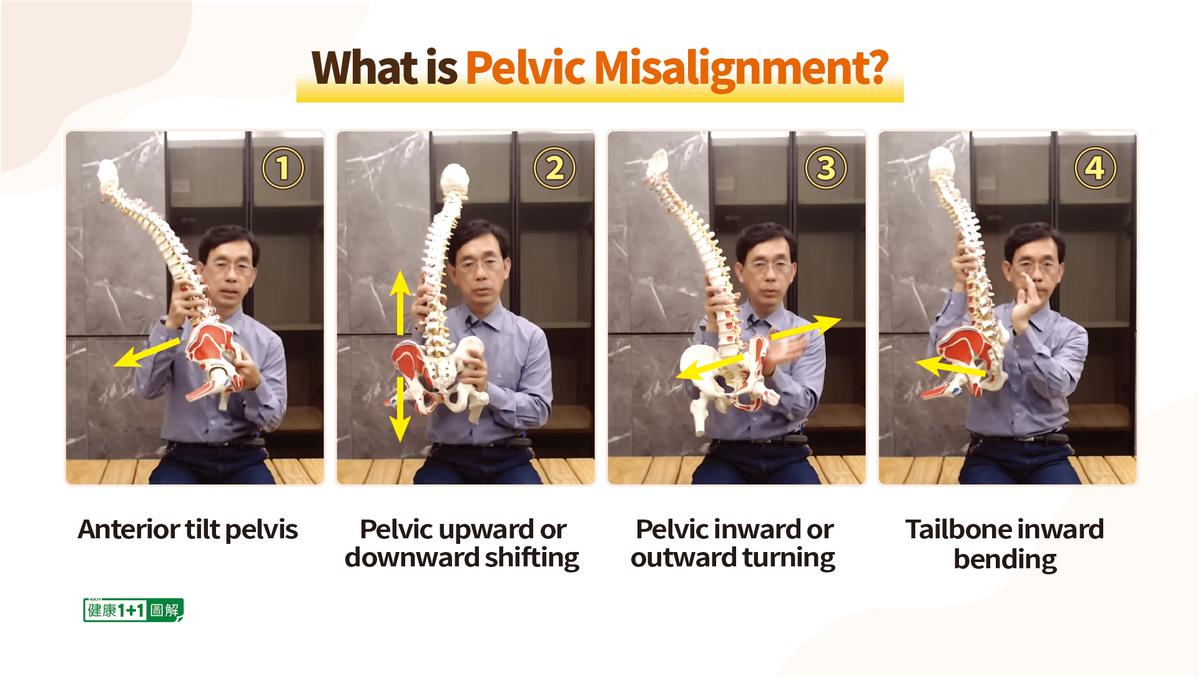
Poor Posture Is the Main Cause of Pelvic Misalignment
Pelvic misalignment is mainly caused by poor posture. For instance, when the feet are often crossed, the ilia will gradually turn outward.On the other hand, pelvic misalignment can also be caused by a fall or an external impact. For example, the tailbone is composed of five small bones, which are more fragile than normal bones. If a strong external force squeezes up from the buttocks, it may cause the tailbone to bend inward.
So, how do we prevent pelvic misalignment in general? The best way is to maintain good posture, such as sitting upright. Since the tailbone is a little higher than the ischia, when one sits upright, it is the lower edges of the ischia, not the tailbone, which will bear the weight of the body. So the tailbone will not be easily compressed or bent.
Pelvic Misalignment Causes Many Symptoms, Including Lumbar Pain
A misaligned pelvis can cause many symptoms. For example, anterior tilting of the pelvis can lead to lower back pain, hunchback, a bulging abdomen and abnormally large hips. Furthermore, it can cause compression of the fourth and fifth vertebrae of the lumbar spine.When the ilia are turned outward or inward, the muscles and ligaments around them will become tight. At the same time, a tilted ilium will also cause the sacrum to tilt along with it, because the sacrum is like the foundation of the spine, so it will further affect the spine and cause symptoms such as back pain.
Besides making the hips look bigger, an outward turned ilia will also tighten the piriformis, which is a deep muscle in the buttocks. Moreover, the tightness of the piriformis will also cause pressure on the lumbar spine and may even lead to sciatica.
If someone falls on one of his or her buttocks, the joint between the ilium and sacrum may become misaligned, causing localized aching pain in one of the hips. The joint itself has limited space for movement, so a slight misalignment can be very uncomfortable. However, the misalignment is not always obvious on an X-ray image.
In addition, a tilted pelvis may even be associated with knee pain. This is because the lateral side of the pelvis is connected to the femur, so it can also affect the knees.
Dr. Wu’s left knee once felt uncomfortable, and he later discovered that it was due to a misaligned ilium. When many people treat their knee pain, they only focus on their kneecaps, but the results are often not satisfactory.
In fact, the best way is to help the patient correct his or her misaligned pelvis first, so that the treatment will become effective.
Method 1 for Pelvic Misalignment
- Lie on a hard bed or yoga mat (all the following exercises are also carried out on a hard bed or yoga mat).
- Bend both legs.
- Twist the ilia up and down (in the direction parallel to the bed, as shown in the picture).
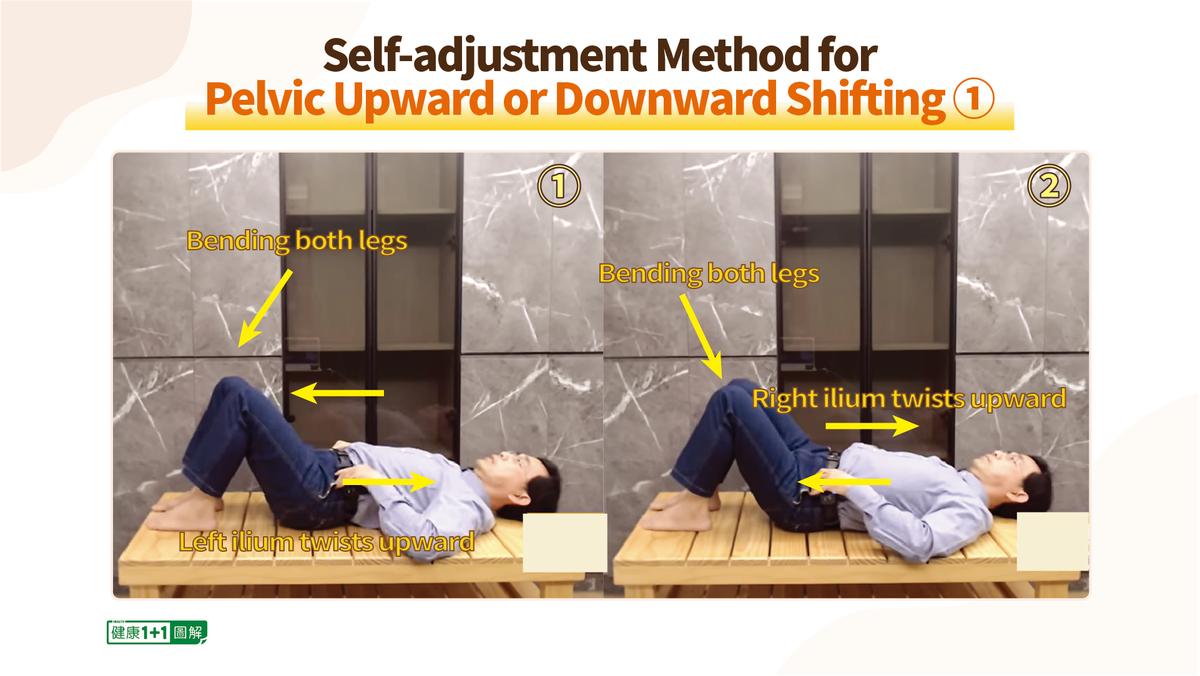
Dr. Wu once had a pregnant patient who accidentally fell and hit her right buttock on the floor and got injured. Afterwards, she felt pain at the junction of her right ilium and sacrum, so she came to Dr. Wu for treatment. After giving her a physical examination, Dr. Wu found that her right ilium had shifted upwards.
Method 2 for Pelvic Misalignment
Furthermore, you can also lie on the bed with your legs bent and sway gently from side to side.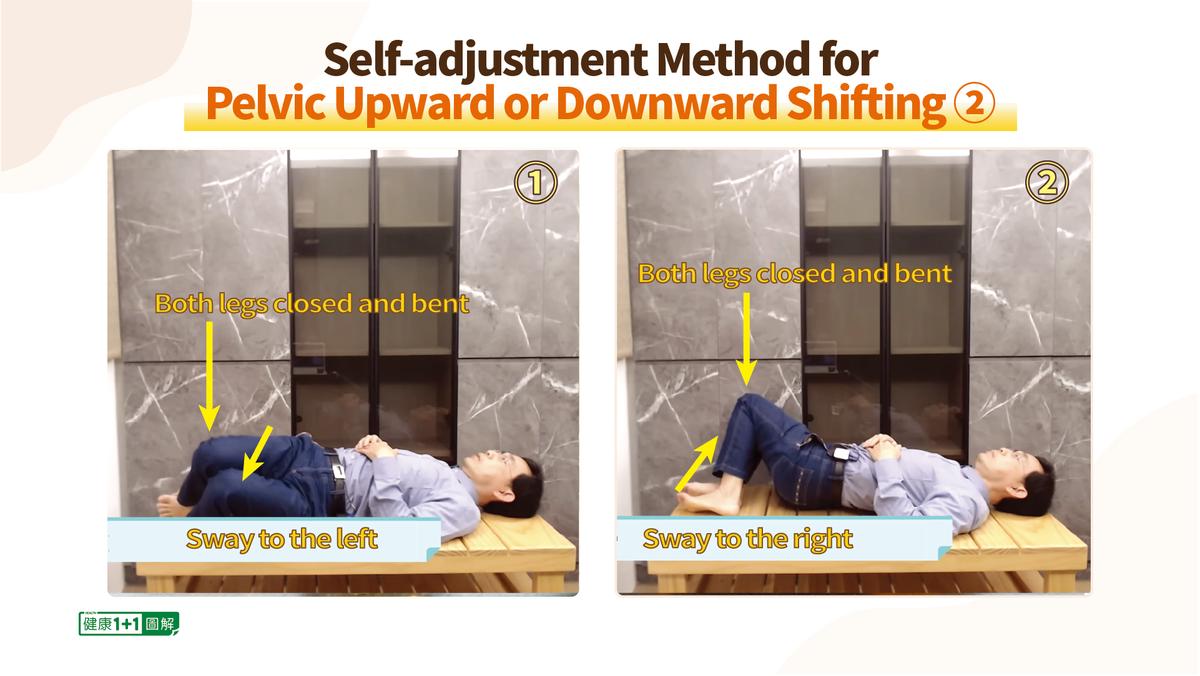
Self-Adjustment Method for an Outward-Turned Pelvis
Dr. Wu refers to this exercise as “muscle energy therapy.” It means using one’s own muscles and ligaments to create some counterforce to loosen the pelvis, so it can return to its normal position.- Lie on the bed with your left leg bent and turn 90° inward.
- Use your right hand to reach the outside of your left kneecap and press the kneecap inward (you can also ask someone else to help you press it). You don’t need to use too much force, about 5 to 6 lb of force is sufficient.
- At the same time, your left knee will resist and push back the force of your right hand for about 7 to 10 seconds.
- Turn the left leg inward some more, and push back your right hand with your left knee again for 7 to 10 seconds. Repeat 3 to 4 times.
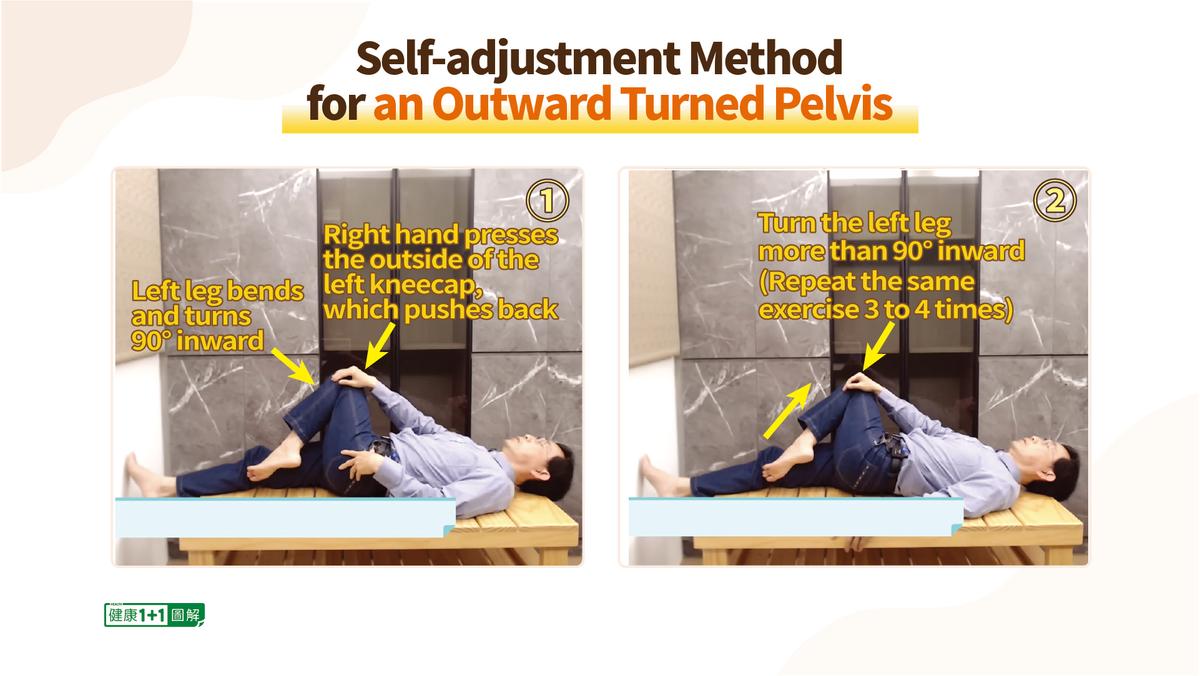
Adjusting an Inward-Turned Pelvis
Assuming that your left pelvis is turned inward, you should:- Lie on the bed with your left leg bent and your left ankle on your right knee, so your legs form a “4” shape.
- Ask someone else to help press down from the inside of your left knee. At the same time, your knee will resist and push back the force of the other person’s hand for about 7 to 10 seconds each time.
- Ask the person to press your left knee down a little further, and then your left knee will resist and push back the force of the person’s hand for about 7 to 10 seconds. Repeat 3 to 4 times.
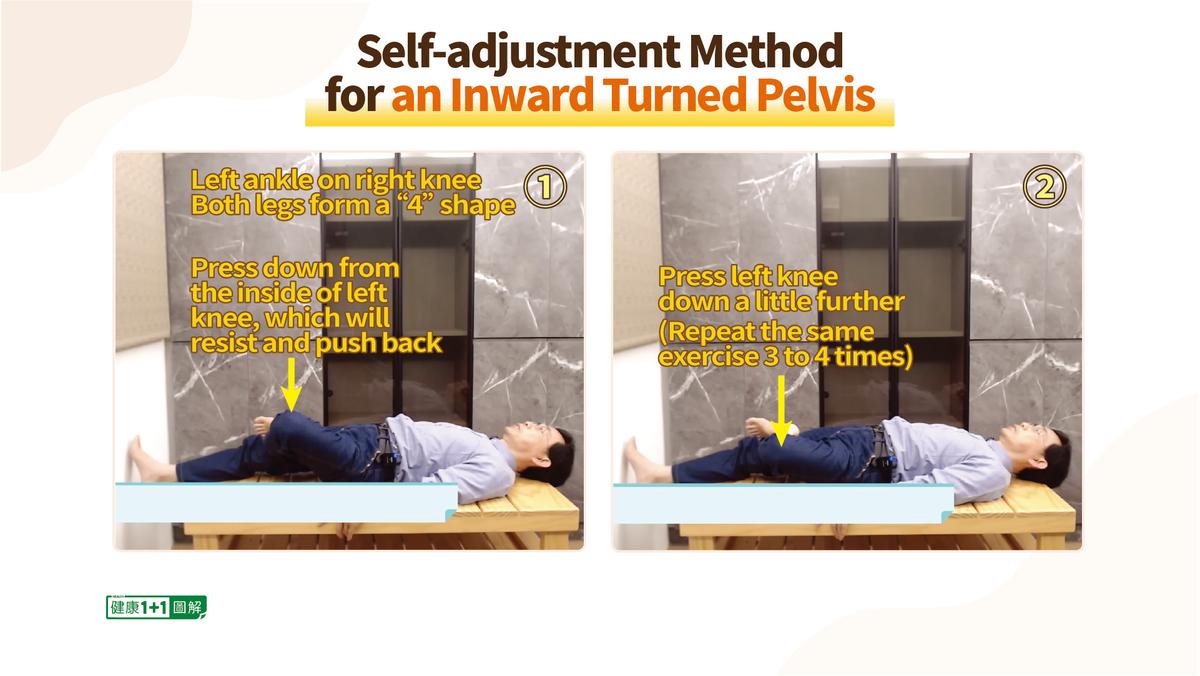
Self-Adjustment Method for a Bent Tailbone
- Lie on the bed and grab the edges of the bed with your hands. Then, put your feet together, and sway from side to side. Do it twice.
- Raise both feet 15°, sway from side to side twice.
- Raise both feet another 15° (a total of 30°), and repeat the same movements twice.
- Lower both feet 15°, sway from side to side twice. Then both feet return to the horizontal position. Repeat the same movements twice.
- When doing this exercise, focus your body weight on the sacrum, and then use your feet’s movements to loosen the joints between the five coccygeal vertebrae, so that the tailbone will slowly flatten.
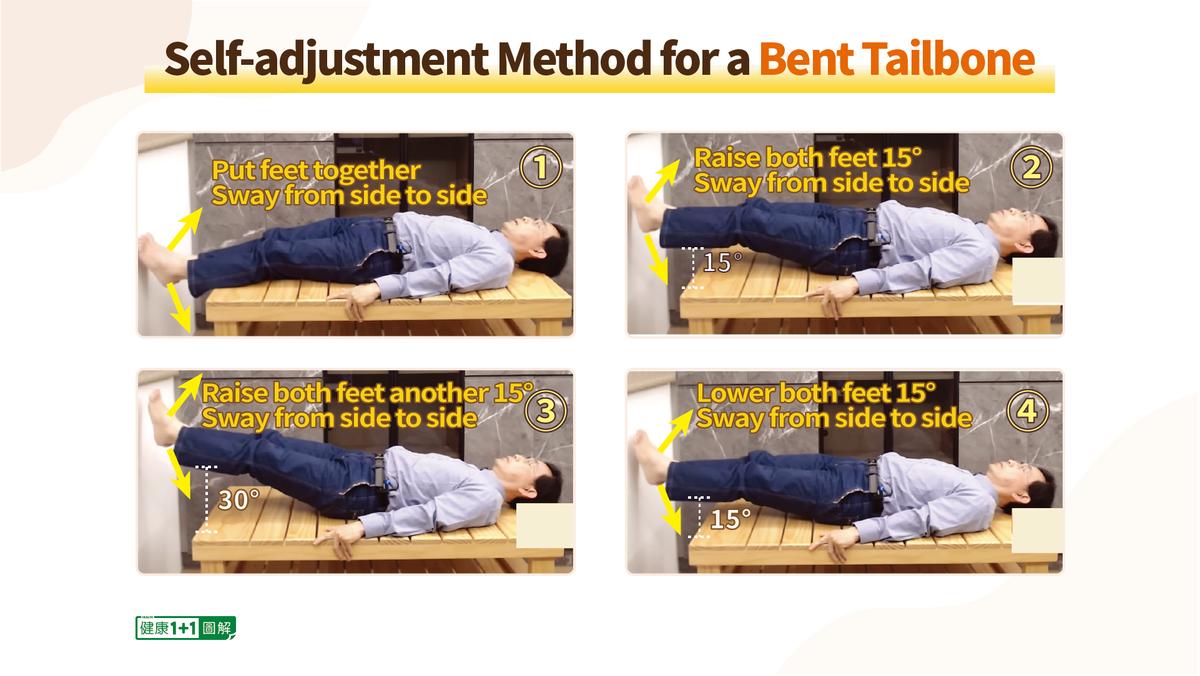
This exercise can also train your abdominal muscles at the same time (if your abdominal muscles are not strong enough, you may not be able to lift your feet). Furthermore, it can also exercise your internal organs, as the nerves extending from the sacrum are connected to the large intestine, so it can also help smooth the bowel movement.
Method to Relax Fascia in the Sacral Area
- Lie on the bed, stretch your hands above your head and press your feet down.
- Wiggle your body like a caterpillar, by shaking your ilia up and down as the starting point, for around 20 times.
- Relax your feet, while no longer pressing them down. Repeat step 2.
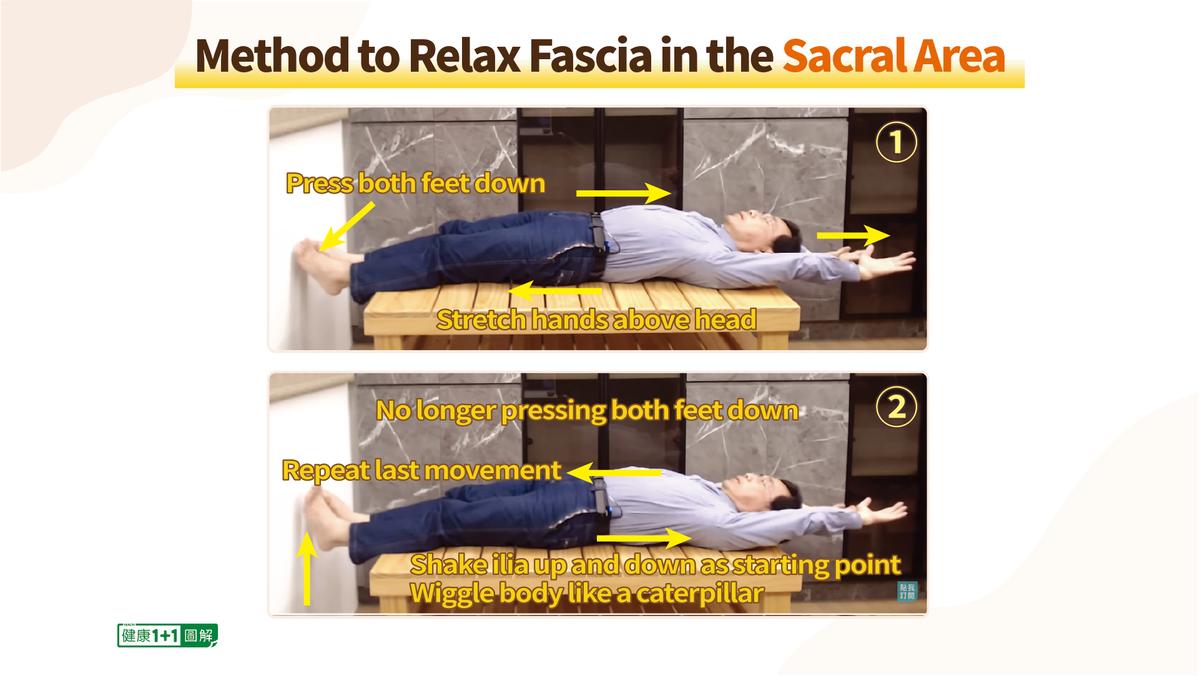
This exercise can relax the muscles and ligaments on both sides of the spine. It is particularly effective to relax the tight fascia in the sacral area.
Another patient of Dr. Wu is an elderly gentleman who always felt soreness in his sacral area, but not pain. Dr. Wu treated him for two months, without good results. He later discovered that the fascia near his patient’s sacrum was very tight, so he taught the gentleman to do this “caterpillar exercise.” And his symptoms improved a lot after just two sessions.
It is worth mentioning that according to Dr. Wu’s clinical experience, most of the people with very sore muscles and bones have very tight fascia. If they take painkillers in this situation, the effect is generally not satisfactory, because the painkillers can stop the pain but not the soreness.
Method to Relax Piriformis
Pelvic misalignment may also cause sciatica. For instance, leg crossing tends to make the pelvis wider, resulting in piriformis tension, which in turn compresses the sciatic nerve and causes pain. In fact, there is a simple way to relax the piriformis:- Lie on the bed, move your left knee towards your chest.
- Pull your left knee towards your right shoulder with both hands. Hold the knee for one minute. You will feel your hip muscles being stretched.
- Switch to the right foot and repeat, so that the piriformes on both sides are loosened at the same time.
- Lift both feet at the same time, with bent knees. Wrap your arms around your knees and shake your knees back and forth to relax the lower back muscles symmetrically.
